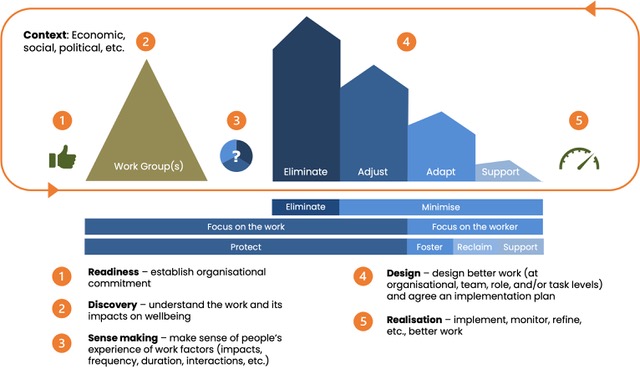Better Work By Design
Better Work By Design Process
Managing psychosocial risks at work
- The Why
- The Process
- Discovery Tools
Necessary (But Not Sufficient)
The evidence is clear – the quality of our work environments profoundly affects our physical and mental health. Work that is well designed, organised, and resourced enables people to thrive, while poorly designed work can exact a heavy toll, causing harm to both physical and mental health.
Many organisations identify work-related psychosocial hazards (e.g., high work demands, pace of change, etc.) and assess the risk associated with those hazards, but do not then follow through to develop appropriate control measures to manage those risks or to design protective psychosocial factors (e.g., flexibility, adequate rest breaks, etc.) into the work.
The BWBD Process
Our Better Work By Design (BWBD) process allows organisations to (i) meet their obligation to identify and manage work-related psychosocial risks as well as (ii) get after the opportunity to design work so that people thrive and organisations succeed.
BWBD is a 5-stage process that enables the identification and management of work-related factors that either harm or are protective of mental health and wellbeing.

The Readiness Stage
Boards and senior leaders need to understand that the intent of BWBD is the design of better work, not simply the identification of psychosocial risks. It is important that senior leaders are given an opportunity to understand what they are committing to and how they can support the process. This is known as the Readiness stage.
The Discovery Stage
The Discovery stage involves engaging workers doing similar work to provide a work-as-done (as opposed to a work-as-imagined) view of their current work in relation to factors that are harmful to, as well as protective of, their wellbeing. In this way, BWBD acknowledges workers as the experts in their work and its impacts.
Check out our Discovery Tools.
The Sense Making Stage
- Who is exposed to the hazards or risks?
- How often are workers exposed to the hazards or risks (frequency)?
- How long are workers exposed to the hazards or risks (duration)?
- How severe are the likely consequences from this exposure (severity)?
- Do these factors combine or interact to cause harm?
Similar questions can be asked about the nature and impact of protective work factors.
The Design Stage
In the Design stage, controls to manage psychosocial hazards – and ways to facilitate protective work factors – are identified. Psychosocial control measures should follow the same hierarchy as is traditionally used for physical safety. In other words, we should focus first on changing the work before looking at what workers can do to prevent or minimise harm.
The most effective controls will eliminate or minimise the psychosocial hazard through elimination and/or the adjustment of work, rather than developing the skills, knowledge, and experience of workers or providing individual counselling. The focus of the design stage could relate to any combination of task, individual, social, and organisational factors.
The Realisation Stage
The Realisation stage involves implementing and monitoring the better work design changes, improvements, and controls identified in the Design stage. This stage also captures the reality that the design and implementation of better work is an iterative, continuous improvement process.
Contact us today to discuss how we can best support you through the BWBD process.
Brains first, and then Hard Work.
– Eeyore, The House at Pooh Corner